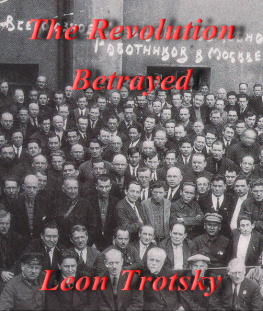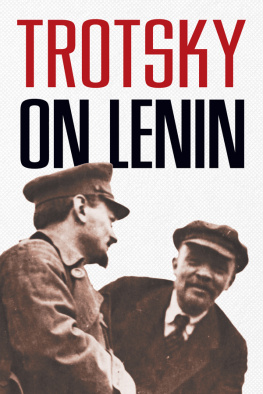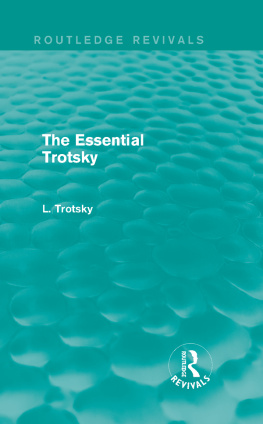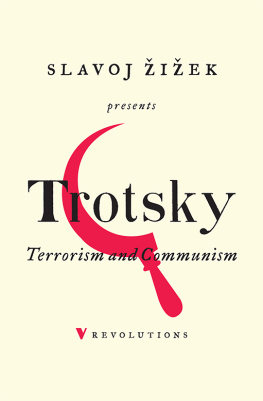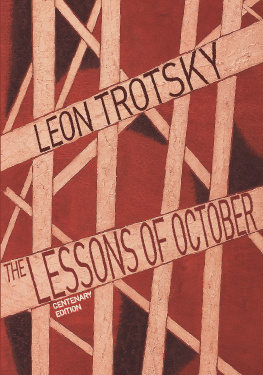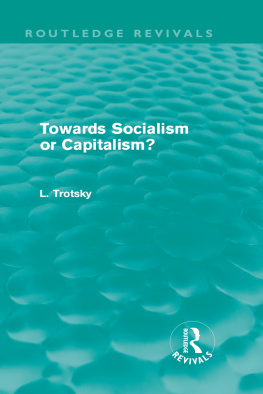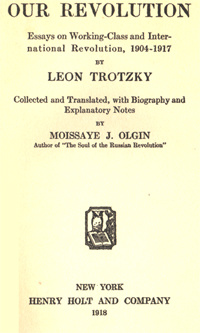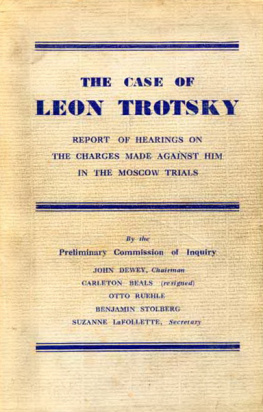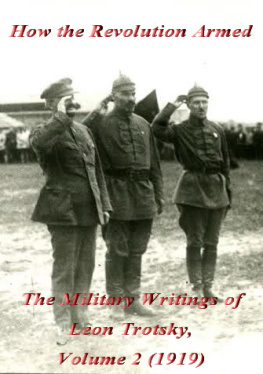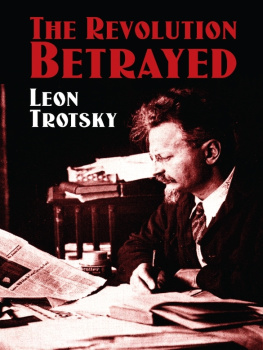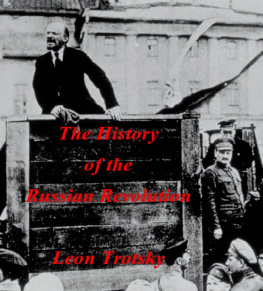Leon Trotsky - The Revolution Betrayed (1936)
Here you can read online Leon Trotsky - The Revolution Betrayed (1936) full text of the book (entire story) in english for free. Download pdf and epub, get meaning, cover and reviews about this ebook. publisher: Marxists Internet Archive, genre: Politics. Description of the work, (preface) as well as reviews are available. Best literature library LitArk.com created for fans of good reading and offers a wide selection of genres:
Romance novel
Science fiction
Adventure
Detective
Science
History
Home and family
Prose
Art
Politics
Computer
Non-fiction
Religion
Business
Children
Humor
Choose a favorite category and find really read worthwhile books. Enjoy immersion in the world of imagination, feel the emotions of the characters or learn something new for yourself, make an fascinating discovery.
- Book:The Revolution Betrayed (1936)
- Author:
- Publisher:Marxists Internet Archive
- Genre:
- Rating:5 / 5
- Favourites:Add to favourites
- Your mark:
- 100
- 1
- 2
- 3
- 4
- 5
The Revolution Betrayed (1936): summary, description and annotation
We offer to read an annotation, description, summary or preface (depends on what the author of the book "The Revolution Betrayed (1936)" wrote himself). If you haven't found the necessary information about the book — write in the comments, we will try to find it.
The Revolution Betrayed (1936) — read online for free the complete book (whole text) full work
Below is the text of the book, divided by pages. System saving the place of the last page read, allows you to conveniently read the book "The Revolution Betrayed (1936)" online for free, without having to search again every time where you left off. Put a bookmark, and you can go to the page where you finished reading at any time.
Font size:
Interval:
Bookmark:
What Has Been Achieved
O wing to the insignificance of the Russian bourgeoisie, the democratic tasks of backward Russia such as liquidation of the monarchy and the semi-feudal slavery of the peasants could be achieved only through a dictatorship of the proletariat. The proletariat, however, having seized the power at the head of the peasant masses, could not stop at the achievement of these democratic tasks. The bourgeois revolution was directly bound up with the first stages of a socialist revolution. That fact was not accidental. The history of recent decades very clearly shows that, in the conditions of capitalist decline, backward countries are unable to attain that level which the old centers of capitalism have attained. Having themselves arrived in a blind alley, the highly civilized nations block the road of proletarian revolution, not because her economy was the first to become ripe for a socialist change, but because she could not develop further on a capitalist basis. Socialization of the means of production had become a necessary condition for bringing the country out of barbarism. That is the law of combined development for backward countries. Entering upon the socialist revolution as the weakest link in the capitalist chain (Lenin), the former empire of the tzars is even now, in the 19th year after the revolution, still confronted with the task of catching up with and outstripping consequently in the first place catching up with Europe and America. She has, that is, to solve those problems of technique and productivity which were long ago solved by capitalism in the advanced countries.
Could it indeed be otherwise? The overthrow of the old ruling classes did not achieve, but only completely revealed, the task: to rise from barbarism to culture. At the same time, by concentrating the means of production in the hands of the state, the revolution made it possible to apply new and incomparably more effective industrial methods. Only thanks to a planned directive was it possible in so brief a span to restore what had been destroyed by the imperialist and civil wars, to create gigantic new enterprises, to introduce new kinds of production and establish new branches of industry.
The extraordinary tardiness in the development of the international revolution, upon whose prompt aid the leaders of the Bolshevik party had counted, created immense difficulties for the Soviet Union, but also revealed its inner powers and resources. However, a correct appraisal of the results achieved their grandeur as well as their inadequacy is possible only with the help of an international scale of measurement. This book will be a historic and sociological interpretation of the process, not a piling up of statistical illustrations. Nevertheless, in the interests of the further discussion, it is necessary to take as a point of departure certain important mathematical data.
The vast scope of industrialization in the Soviet Union, as against a background of stagnation and decline in almost the whole capitalist world, appears unanswerably in the following gross indices. Industrial production in Germany, thanks solely to feverish war preparations, is now returning to the level of 1929. Production in Great Britain, holding to the apron strings of protectionism, has raised itself 3 or 4 per cent during these six years. Industrial production in the United States has declined approximately 25 per cent; in France, more than 30 per cent. First place among capitalist countries is occupied by Japan, who is furiously arming herself and robbing her neighbors. Her production has risen almost 40 per cent! But even this exceptional index fades before the dynamic of development in the Soviet Union. Her industrial production has increased during this same period approximately 3 times, or 250 per cent. The heavy industries have increased their production during the last decade (1925 to 1935) more than 10 times. In the first year of the five-year plan (1928 to 1929), capital investments amounted to 5.4 billion rubles; for 1936, 32 billion are indicated.
If in view of the instability of the ruble as a unit of measurement, we lay aside money estimates, we arrive at another unit which is absolutely unquestionable. In December 1913, the Don basin produced 2,275,000 tons of coal; in December 1935, 7,125,000 tons. During the last three years the production of iron has doubled. The production of steel and of the rolling mills has increased almost 2 times. The output of oil, coal and iron has increased from 3 to 3 times the pre-war figure. In 1920, when the first plan of electrification was drawn up, there were 10 district power stations in the country with a total power production of 253,000 kilowatts. In 1935, there were already 95 of these stations with a total power of 4,345,000 kilowatts. In 1925, the Soviet Union stood 11th in the production of electro-energy; in 1935, it was second only to Germany and the United States. In the production of coal, the Soviet Union has moved forward from 10th to 4th place. In steel, from 6th to 3rd place. In the production of tractors, to the 1st place in the world. This also is true of the production of sugar.
Gigantic achievement in industry, enormously promising beginnings in agriculture, an extraordinary growth of the old industrial cities and a building of new ones, a rapid increase of the numbers of workers, a rise in cultural level and cultural demands such are the indubitable results of the October revolution, in which the prophets of the old world tried to see the grave of human civilization. With the bourgeois economists we have no longer anything to quarrel over. Socialism has demonstrated its right to victory, not on the pages of Das Kapital, but in an industrial arena comprising a sixth part of the earths surface not in the language of dialectics, but in the language of steel, cement and electricity. Even if the Soviet Union, as a result of internal difficulties, external blows and the mistakes of leadership, were to collapse which we firmly hope will not happen there would remain an earnest of the future this indestructible fact, that thanks solely to a proletarian revolution a backward country has achieved in less than 10 years successes unexampled in history.
This also ends the quarrel with the reformists in the workers movement. Can we compare for one moment their mouselike fussing with the titanic work accomplished by this people aroused to a new life by revolution? If in 1918 the Social-Democrats of Germany had employed the power imposed upon them by the workers for a socialist revolution, and not for the rescue of capitalism, it is easy to see on the basis of the Russian experience what unconquerable economic power would be possessed today by a socialist bloc of Central and Eastern Europe and a considerable part of Asia. The peoples of the world will pay for the historic crime of reformism with new wars and revolutions.
The dynamic coefficients of Soviet industry are unexampled. But they are still far from decisive. The Soviet Union is uplifting itself from a terrible low level, while the capitalist countries are slipping down from a very high one. The correlation of forces at the present moment is determined not by the rate of growth, but by contrasting the entire power of the two camps as expressed in material accumulations, technique, culture and, above all, the productivity of human labour. When we approach the matter from this statistical point of view, the situation changes at once, and to the extreme disadvantage of the Soviet Union.
The question formulated by Lenin Who shall prevail? is a question of the correlation of forces between the Soviet Union and the world revolutionary proletariat on the one hand, and on the other international capital and the hostile forces within the Union. The economic successes of the Soviet Union make it possible for her to fortify herself, advance, arm herself, and, when necessary, retreat and wait in a word, hold out. But in its essence the question, Who shall prevail not only as a military, but still more as an economic question confronts the Soviet Union on a world scale. Military intervention is a danger. The intervention of cheap goods in the baggage trains of a capitalist army would be an incomparably greater one. The victory of the proletariat in one of the Western countries would, of course, immediately and radically alter the correlation of forces. But so long as the Soviet Union remains isolated, and, worse than that, so long as the European proletariat suffers reverses and continues to fall back, the strength of the Soviet structure is measured in the last analysis by the productivity of labour. And that, under a market economy, expresses itself in production costs and prices. The difference between domestic prices and prices in the world market is one of the chief means of measuring this correlation of forces. The Soviet statisticians, however, are forbidden even to approach that question. The reason is that, notwithstanding its condition of stagnation and rot, capitalism is still far ahead in the matter of technique, organisation and labour skill.
Font size:
Interval:
Bookmark:
Similar books «The Revolution Betrayed (1936)»
Look at similar books to The Revolution Betrayed (1936). We have selected literature similar in name and meaning in the hope of providing readers with more options to find new, interesting, not yet read works.
Discussion, reviews of the book The Revolution Betrayed (1936) and just readers' own opinions. Leave your comments, write what you think about the work, its meaning or the main characters. Specify what exactly you liked and what you didn't like, and why you think so.

